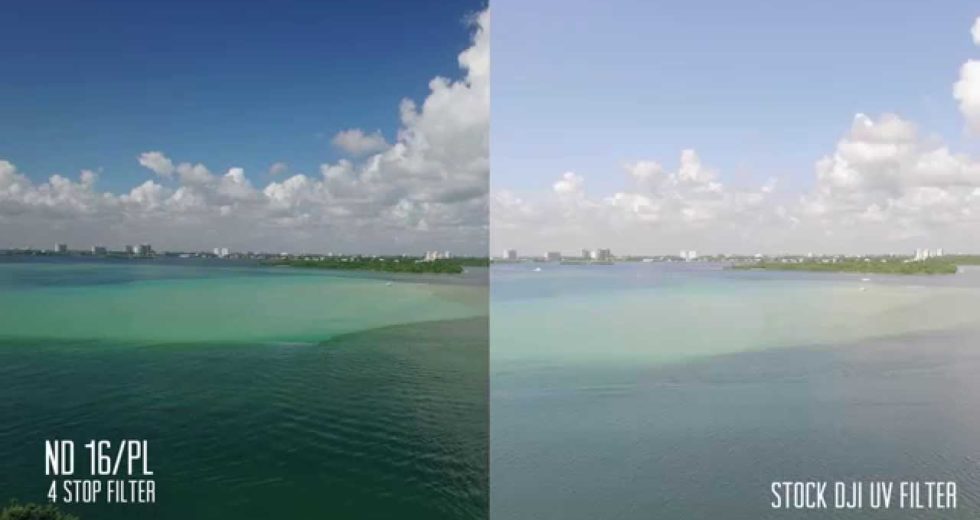Out of the box your DJI drone is simple to set up and start flying right away. Even recording your first videos is a snap. But the more video you shoot the more you’re going to notice the effects of too much light on the quality of your video.
In some cases you might think your camera is bad or that you’re doing something wrong. It’s not you. It’s just that your lens needs some help dealing with the light you’re shooting in.
Enter the Neutral Density, or ND, filter.
How does a Neutral Density Filter work?
In simple terms an ND filter reduces the amount of light allowed into the lens so the camera can capture better looking images that aren’t overwhelmed by light.. Shooting scenes with lots of sky, water or snow are good examples of times when your camera might be challenged to produces video and images that are satisfactory.
A Neutral Density filter acts like sunglasses for your camera. When you’re outside on a bright day without eye protection, the bright sunlight forces your iris to expand to limit the light coming into your eyes. If it’s bright enough you might also be squinting since your eyelids want to partially close to protect your eyes. The neutral part of it means that the filter treats all wavelengths of light equally. The throttling of light entering the lens is the same regardless of wavelength.
Ken Heron’s Phantom 4 video(below) shows some great examples of how Neutral Density filters have a dramatic effect on video image quality:
When our auto-metering cameras try to film with “sunglasses” they will compensate for the exra light by reducing the aperture. The aperature of a camera widens or narrows depending on the conditions and the intentions of the photographer. The wider, or more open the aperature the more light gets in the lens and the shallower the depth of field will be. A good example is a simple portrait where the background is blurred.
When shooting landscapes most photographers will stop the camera down to a smaller aperature which creates a much deeper depth of field, so everything in the photo is in focus. But regardless of the aperature, the image is competing for lens space with light. The light of the image itself plus whatever extra light your’re shooting under.
Modern cameras with smart meters and lots of automatic settings will try to compensate for the light by speeding up the shutter speed, which can have the side effect of reducing image quality. To compensate we can use a neutral density filter to allow the camera slow down, preserving the quality of the image.
Many drone videographers are aiming to bring three numbers together for better quality video capture: the ISO, shutter speed and frame rate. Without getting into an even longer discussion about frame rate, we’ll assume you’re shooting in 1080 or 4k at 60 frames per second (fps). This will allow you to capture sweeping scenery that can be slowed down in production for to suit your needs.
Rules of Thumb
Like shooting still photography, we want to aim for a reasonably low ISO of 100 for good quality. Before the days of digital cameras the ISO reflected the speed of the film being used. I remember using an ISO 25 film to capture ultra high quality images. Today the ISO setting lets us choose the light sensitivity of the camera. Once we’ve chosen the ISO and frame rate the internal computer in the camera is going to meter the light and decide what the shutter speed should be. The more light it detects the faster it moves the shutter, and the faster the shutter speed the lower the ultimate quality of the image. Most drone videographers will agree that 1/50th shutter speed is a good, basic rule of thumb.
Let’s use a hypothetical example of setting up our DJI Mavic Pro drone for an afternoon at the beach. On a typical summer day all of that sunshine is going to be amplified by a wide open sky and all of the water. We need to help the camera to better absorb the images by putting sunglasses on it to throttle the light because ideally we want to shoot with a low ISO like 100.
In our app we can see that the drone camera wants to shoot at 1/400th of a second, which is pretty quick. But you’ll remember from above that our target speed is to shoot closer to 1/50th of a second. Enter the Neutral Density Filter.

ND Filters usually come in a set with graduated numbers. The DJI set, left, for the Mavic Pro drone has three ND Filters; ND4, ND8 and ND16. Understanding what the numbers after ND means is simple. Just invert the number (ND4 inverted becomes 1/4th) and you understand that the ND4 filter lets in 1/4 of the light. An ND8 filter lets in 1/8th of the light and so on.
DJI sells a set of three ND filters for it’s Mavic Pro drone (left) that retail for $35. See them here.
Back to our beach example
So going back to our setup for filming at the beach, with the camera trying to shoot at 1/400th, we want to reduce the amount of light so the camera will shoot at 1/50th. This is the easy part. Divide the actual shutter speed, 400 in this case by the speed you want 50, and the answer is 8. So we want to use the ND8 filter.
For the average drone enthusiast, a set with ND2, ND8 and ND16 will likely be sufficient, or at least a good start to begin experimenting. If you decide to do more advance filming and experimentation you can always add to your collection. If you don’t want to do the simple math in the field, just put a sticker somewhere on your filter case or controller with the following chart:
1/200th = ND2
1/400th = ND8
1/800th = ND16
Remember, that all of this is really some math that’s applied to a rule of thumb. It won’t be perfect in every situation. The more video you shoot and the more you experiment with your filters the better you’ll understand them and become more accustomed to their effect on image quality.
Always buy the best quality filters you can afford. The photos and videos you are shooting are the product. The glass filter that the image goes through before hitting the camera sensor isn’t where you should try to save money. You honestly get what you pay for.

We highly recommend the PolarPro Vivid Series ND filters for the DJI Mavic Pro. You’ll notice immediately the higher quality feel of the filters and the added polarization is a bonus that will give you sky with a blue that pops and will reduce the glare on water. The PolarPro Vivid Series are available at Amazon with free shipping for about twice the cost of the DJI filters.
DJI has also published a guide on ND Filters as well, you can read it here.
For a complete list of Mavic Pro parts and accessories, including Neutral Density filters, please check out our list here.

